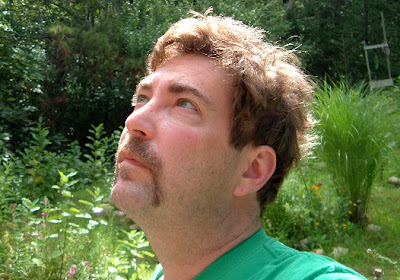
As I dashed about my morning, addressing things more mundane than the merry planting of pansies (vacuuming, catbox, corraling assorted wandering glasses and plates for the dishwasher, shaving and so on...), I happened to glance out the window and saw a tiny flash of red in the dull colors of the browns and grays of the hill and the remains of last year's foliage.
This bird I recognized right off: the Northern Flicker (yellow-shafted east coast variety, natch). I've only seen a flicker one other time, some Easter sunday about fifteen years gone by, in our yard in the Adirondacks. But they are beautifully memorable.

I'll apologize right here for the photo quality, but I was shooting through a window still sheathed in insulating plastic, and not yet properly washed since our arrival on this misfortunate shore...so actually, I think these pics came out pretty well!
Actually, the window's in the room with the slightly unstable floor, too. I was trying hard to be extra quiet, but there was a moment when it was clear he knew I was inside, watching.
Anyway, the flicker's quite a cool bird, with its yellow and white speckled body, dark crescent bar on his chest and a slash of a red crown on the back of his head. I want to say they are about pigeon-sized, though their demeanor is...at a loss here...more woodpecker-y. The flicker's legs aren't as long, but it reminds me of the green heron we had visit us one spring in Eastham.
Being one of the larger members of the woodpecker family makes them kind of distinctive amongst a world of smaller birds. Foraging on the ground for ants and grubs distinguishes him from many of his woodpecker brethren...at least, among the few varieties I usually see.

Flickers are also known far and wide by annoyed homeowners, due to the loud rapping against the outsides of people's houses being an integral part of their mating call. In keeping with the Principles of Murphy, the louder the rapping, the more the girl bird is meant to be impressed.
So far, we've had none of that from this guy, since this was his first appearance (to me, anyway) on our stage.

I enjoyed watching him, as he pecked into the dirt of the hillside, his long beak loosening and tossing the soil as he searched for ants and grubs. He moved in an uneven line across the side of the hill, moving closer to the apple tree...and really, he was working toward the same goal as I am, in cleaning and rejuvenating this hillside into something more beautiful than the utilitarian lump it is now. Who knows what sorts of seeds his rooting around in there might activate?
I can imagine the wild (extant) growth out there dotted with the occasional dwarf evergreen or clump of daylilies or creeping phlox, not only for erosion control, but also as cover for the many birds who forage out there in the open every day. This guy was particularly alert as he went about his work, not only glancing toward my vantage point from time to time, but also regularly stopping his digging to scan the open skies above.
That last shot is probably not the best of the bunch, but the only one where you catch the slightest glimpse of the red stripe on his head.








2 comments:
Those pictures of the Flicker were great. I needed to adjust my eyes to see the bird expertly camouflaged among the brush. You must have had a good eye to catch this.
Thanks.
Thanks, Butch. I was actually thinking of you and your comment about photo quality on your own blog recently as I posted these. What with the "media" I was shooting from and the movement of the bird, I had to play around with the exposure of the pics a lot before I got them good enough to share...and like you say, nature still helps our bird friends stay hidden.
Post a Comment